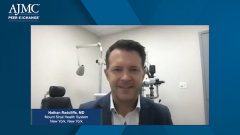
Factors Guiding Selection of Therapy for Glaucoma
Expert perspectives on the factors that inform therapy selection when managing patients with glaucoma.
Episodes in this series

Transcript:
Neil Minkoff, MD: One of the things that I’m trying to get my arms around here is that we’ve been talking about prostaglandin analogues as being the first step or a foundational drug. One of the things that I still am not sure I understand is when you switch to a different 1 vs when you add a new therapy vs when you switch to a different class. That’s 1 of the things that we in managed care struggle with in terms of understanding your treatment pathway and where switching is appropriate vs addition is appropriate vs going to a whole new class, especially now that there are new medications.
Terri-Diann Pickering, MD: In general, I do try to switch within the prostaglandin class because of its efficacy and because of the once-a-day dosing of that class. So if I start with 1 and it doesn’t work, I’ll keep trying, maybe 2 or 3 even different drops to see if I can get a response. The advantage of having a patient on just a once-a-day drop is great. It’s important. If I get a partial response with a prostaglandin, that’s when I’ll add a second agent. Again, the advantage of something like the fixed combination with a prostaglandin and netarsudil [Rhopressa] is that you’re avoiding the multi-bottle therapy and that helps with adherence.
Nathan Radcliffe, MD: It comes down to some math. If you added a medicine to generic latanoprost [Xalatan], you could avoid adding a medicine by switching some percentage of the time, whether it’s 20%, 25%, or 15%. But that fraction of patients that is now going to be able to be on just the brand name prostaglandin analogue instead of 2 bottles is happy about that and they’ll be more compliant, and their disease will probably be better controlled. It’s a game of fractions, but you try to max the PGA [prostaglandin analogs] class out, which involves going to a brand name therapy, before you add. And you can’t switch from a PGA because even the fixed combinations just have similar efficacy. They don’t have better efficacy.
Terri-Diann Pickering, MD: There are many problems with eye drops, but regardless of the class, they can all cause burning. They can all cause redness and long-term dryness. They have these negative adverse effects. The other thing is the actual dosing of drops themselves. When you put the drops in, we instruct our patients, close your eyes and keep them closed for 3 to 5 minutes. If you’re used to taking a pill and taking another pill, taking another pill you can be done in a minute. Eye drops are not like that. You need to dose them properly. If you’re on 2 drops, it can take you 6 to 10 minutes. If you’re on 3 drops, it can take you 9 to 15 minutes. This is a significant chunk of time. We’re looking at people who have to do this indefinitely for the rest of their lives and telling them if they don’t, they could go blind. Anything that we can do to simplify their regimen is worthwhile.
Neil Minkoff, MD: I understand the concept of the combination and we touched on the need or the desire to have 1 vial. What are the disadvantages? One of the things that we think about in managed care is can we combine 2 generics before we go to a branded combination in 1 vial. What are the difficulties of having 2 different drugs being used not in a combination, a predetermined combination but having 1 eye drop and then another eye drop?
Nathan Radcliffe, MD: I’m going to take a swing at that. There’s probably at least twice the amount of preservative going into the patient’s eye. Because most of the other non-PGA agents are bid [twice a day]. agents, you’re not just doubling the number of eye drop applications, you’re tripling it because they’re going to have to take that second drop twice a day. That gets into confusion. From a patient’s perspective, there’s that effort and that time, as Dr Pickering just explained. The dryness is going to come faster, but then for them there’s probably 2 copays and depending on how things work out, that may or may not be better even in a brand name therapy. It’s why we all try to simplify I know it’s very clear that compliance is tied to the simplicity of the regimen. I use the term confusion a lot because maybe a third of my patients just take their drops incorrectly. And 1 drop once a day is about, a good portion of patients that’s as much as they can handle perfectly. and then anything you add is going to get taken incorrectly.
Neil Minkoff, MD: At what point do you move from single therapy to combination therapy? How long do you give the patient? What are you looking for in terms of intraocular pressure and so on?
Terri-Diann Pickering, MD: When I start any medication, I see the patient again in 2 to 3 weeks and look for a response and then decide. If it is a prostaglandin, do I switch it in the class or do I add an agent? Do I switch to a completely different class? We don’t have to wait that long. The drops work quickly. The longest I would wait would be 3 weeks, but we should know pretty much right away. Of course, once we lower pressure by a certain amount, we do have to recheck the patient’s glaucoma tests; their visual fields, their optic nerve scans. If we see that they’re deteriorating even though we’ve lowered pressure by 20%, we know that we’ve got to lower it an additional 10% to 20%. That may also trigger the need for adding or switching medication. And we typically recheck the tests in 6 to 12 months.
Transcript edited for clarity.
Newsletter
Stay ahead of policy, cost, and value—subscribe to AJMC for expert insights at the intersection of clinical care and health economics.


































































